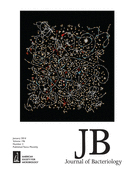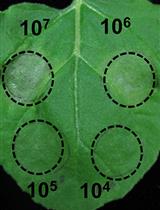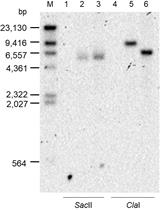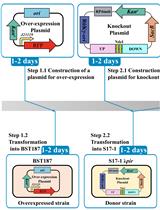- EN - English
- CN - 中文
Conjugation Assay for Testing CRISPR-Cas Anti-plasmid Immunity in Staphylococci
接合实验检测葡萄球菌CRISPR-Cas的抗质粒免疫功能
发布: 2017年05月05日第7卷第9期 DOI: 10.21769/BioProtoc.2293 浏览次数: 13083
评审: Lionel SchiavolinBenoit ChassaingDaan C. Swarts
Abstract
CRISPR-Cas is a prokaryotic adaptive immune system that prevents uptake of mobile genetic elements such as bacteriophages and plasmids. Plasmid transfer between bacteria is of particular clinical concern due to increasing amounts of antibiotic resistant pathogens found in humans as a result of transfer of resistance plasmids within and between species. Testing the ability of CRISPR-Cas systems to block plasmid transfer in various conditions or with CRISPR-Cas mutants provides key insights into the functionality and mechanisms of CRISPR-Cas as well as how antibiotic resistance spreads within bacterial communities. Here, we describe a method for quantifying the impact of CRISPR-Cas on the efficiency of plasmid transfer by conjugation. While this method is presented in Staphylococcus species, it could be more broadly used for any conjugative prokaryote.
Keywords: Conjugation (接合)Background
CRISPR-Cas (Clustered, regularly interspaced, short palindromic repeats-CRISPR associated) is a prokaryotic adaptive immune system found in almost 90% of sequenced archaea and about 40% of bacteria (Makarova et al., 2015). These systems recognize and destroy nucleic acid invaders in a sequence-specific manner (van der Oost et al., 2014). A CRISPR locus typically contains an array of short DNA repeats (~35 nucleotides in length) separated by equally-short unique sequences called spacers, which are often derived from mobile genetic elements. The repeats and spacers are transcribed and processed into small CRISPR RNAs (crRNAs) that each specifies a single target. crRNAs assemble with one or more Cas proteins to form an effector complex that recognizes and degrades nucleic acids that bear a sequence, called a protospacer, complementary to the crRNA. Depending on the CRISPR-Cas type present in an organism, other limitations exist on target recognition, such as the presence of a short protospacer-adjacent motif (PAM) required for targeting by Type I and II systems (Mojica et al., 2009) or the requirement in Type III systems for specific base-pair mismatches between the crRNA and the target (Marraffini and Sontheimer, 2010). Nucleic acid invaders targeted by CRISPR-Cas are typically bacteriophages or mobile genetic elements such as plasmids or transposons that often carry virulence factors, including antibiotic resistance genes and toxins (Novick, 2003; Liu et al., 2016). CRISPR-Cas is thus a potential major barrier to the spread of virulence factors within prokaryotes and has been shown to prevent conjugative transfer of antibiotic resistance plasmids within human clinical isolates of Staphylococcus species (Marraffini and Sontheimer, 2008). Some staphylococci, including human pathogenic isolates of S. epidermidis and S. aureus, the two Staphylococcus species most commonly found in human infections, carry CRISPR-Cas systems (Cao et al., 2016; Li et al., 2016). Within these strains, multiple CRISPR spacers have been found that naturally bear homology to mobile staphylococcal plasmids, indicating that these organisms are capable of using CRISPR-Cas to limit the spread of virulence factors (Samai et al., 2015; Li et al., 2016). Investigations of the effect of mutations within the cas genes and the repeat-spacer array in Staphylococcus on anti-plasmid immunity have provided key insights into the function and mechanisms of Type III-A CRISPR-Cas in S. epidermidis RP62a (Hatoum-Aslan et al., 2011 and 2014; Maniv et al., 2016). Notably, similar assays have been used for mechanistic CRISPR-Cas studies in other organisms, including Enterococcus faecalis, Escherichia coli, and Listeria monocytogenes (Richter et al., 2014; Sesto et al., 2014; Price et al., 2016). Other methods of quantifying CRISPR anti-plasmid immunity, namely transformation via electroporation, have been used (Cao et al., 2016); however, this method cannot be used in non-competent or weakly/selectively competent organisms such as L. monocytogenes and many strains of Staphylococcus (Monk et al., 2012; Sesto et al., 2014). In these organisms, conjugation assays provide not only a viable alternative, but also a more physiologically relevant means of testing CRISPR-Cas anti-plasmid immunity. Described below is a quantitative method to determine the efficacy of CRISPR-mediated interference of the transfer of conjugative plasmid pG0400 between S. aureus and S. epidermidis. While this protocol focuses on staphylococci, it could be adapted for any prokaryotes capable of conjugation.
Materials and Reagents
- 15 ml centrifuge tubes (VWR, catalog number: 21008-216 )
- 1.7 ml microcentrifuge tubes (VWR, catalog number: 87003-294 )
- 0.45 μm membrane filters, 25 mm (EMD Millipore, catalog number: HAWP02500 )
- 50 ml centrifuge tubes (VWR, catalog number: 21008-242 )
- Pipette tips with filter, 100-1,000 μl (VWR, catalog number: 89003-060 )
- Pipette tips with filter, 1-200 μl (VWR, catalog number: 89003-056 )
- Pipette tips with filter, 1-40 μl (VWR, catalog number: 89003-048 )
- 100 x 15 mm Petri dishes (VWR, catalog number: 25384-088 )
- 0.2 ml PCR strip tubes (VWR, catalog number: 20170-004 )
- 1 mm path length cuvettes (VWR, catalog number: 97000-586 )
- Recipient S. epidermidis RP62a (Christensen et al., 1985), bearing a CRISPR-Cas system (see Note 1) (ATCC, catalog number: 35984 )
- Donor S. aureus RN4220 (Kreiswirth et al., 1983), bearing the conjugative plasmid pG0400 (Morton et al., 1995) (see Note 2) (ATCC, BEI Resources, catalog number: NR-45913 )
- Negative control S. epidermidis LAM104 (Marraffini and Sontheimer, 2008), lacking the CRISPR repeat-spacer array (see Note 3)
- Mupirocin (The United States Pharmacopeial Convention, catalog number: 1448901 )
- Brain-heart infusion broth (BD, BBL, catalog number: 211060 )
- Brain-heart infusion agar (BD, Difco, catalog number: 241830 )
- Tryptic soy broth (BD, BactoTM, catalog number: 211822 )
- Neomycin sulfate (AMRESCO, catalog number: 0558-25G )
- Brain-heart infusion broth (see Recipes)
- Brain-heart infusion agar (see Recipes)
- Tryptic soy broth (see Recipes)
Equipment
- Micropipettes set (Eppendorf, model: Research® Plus )
- 37 °C incubator (Thermo Fisher Scientific, Thermo ScientificTM, model: HerathermTM Advanced Protocol Microbiological Incubators )
- 37 °C incubated shaker capable of 160 rpm (Eppendorf, model: I26 )
- Autoclave (Getinge)
- Spectrophotometer (GE Healthcare, model: UltroSpec 10 )
- Microcentrifuge (Thermo Fisher Scientific, Thermo ScientificTM, model: HeraeusTM PicoTM 17 )
- Digital vortex mixer (VWR, model: Advanced Heavy-Duty Vortex Mixer )
- Inoculating wire loop
- Forceps
- Magnetic stir plate
Procedure
文章信息
版权信息
© 2017 The Authors; exclusive licensee Bio-protocol LLC.
如何引用
Walker, F. C. and Hatoum-Aslan, A. (2017). Conjugation Assay for Testing CRISPR-Cas Anti-plasmid Immunity in Staphylococci. Bio-protocol 7(9): e2293. DOI: 10.21769/BioProtoc.2293.
分类
微生物学 > 微生物遗传学 > 转化
微生物学 > 微生物生物化学 > DNA
分子生物学 > DNA > 转化
您对这篇实验方法有问题吗?
在此处发布您的问题,我们将邀请本文作者来回答。同时,我们会将您的问题发布到Bio-protocol Exchange,以便寻求社区成员的帮助。
Share
Bluesky
X
Copy link













